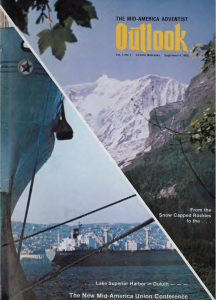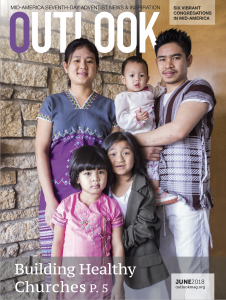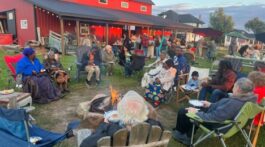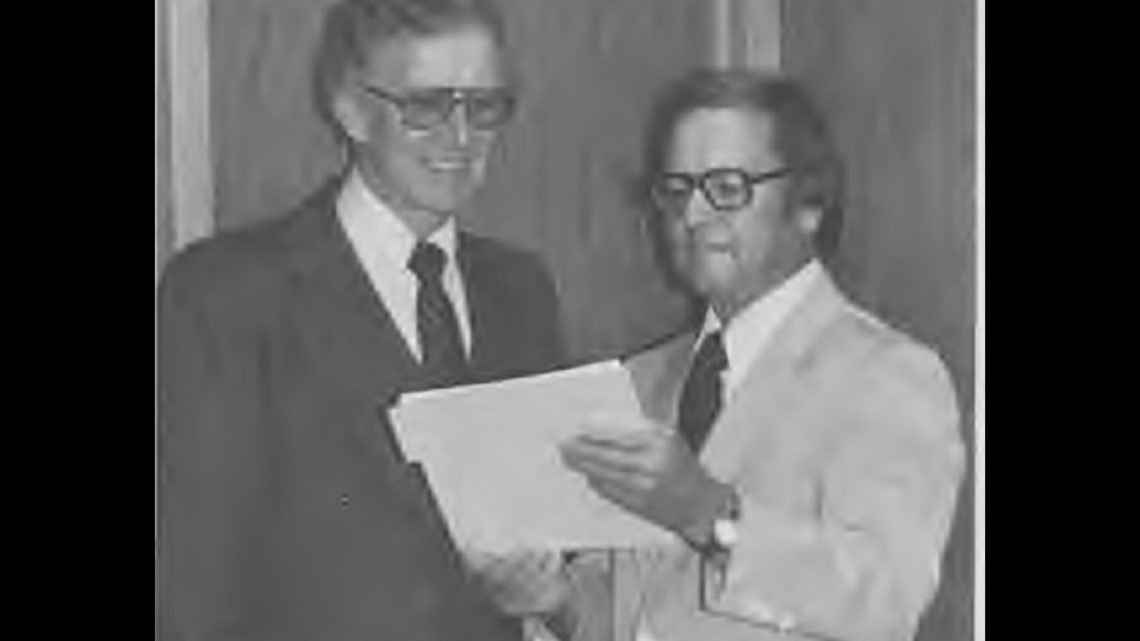This article is the last in a series of five articles on the history of OUTLOOK. To see the other articles in this series, click here.
Nearly 50 years after Elder J. L. McElhany first proposed a merger of the Central and Northern Unions while speaking to the union leaders at the Rome Hotel in Omaha, Nebraska, there again began to be suggestions the two unions should merge. Back in 1932, the unions had followed McElhany’s advice and merged, but the merger only lasted five years. The unions separated in 1937, citing the ability to more closely work with conferences and build up the constituency with the existence of two unions. Now, because of the economic recession of the 1970s, decreasing tithe income, and increasing inefficiency within the unions, leaders were again pushing to merge the unions.
E. L. Marley, president of the Northern Union Conference, wrote in the Northern Union Outlook, “It is becoming increasingly more difficult, for instance, to financially operate an academy, with a small conference as a supporting base … With inflation, operating costs have increased tremendously.”
Marley argued that a larger supporting base would be able to offset the rising costs yet stagnant growth. “Both Unions, independently of each other, in studying the problem came to the conclusion that the only solution to the future survival of our academies is to realign conference boundaries and thus provide a strong enough base to support not only a good academy program, but also a strong viable conference program without the special aid of small conference assistance funds which many of our conferences are having to depend upon at the present time for survival,”1 wrote Marley.
The Northern Union was the smallest union in North America at the time with only 15,000 members, and it was financially strained trying to support its conference entities. The Central Union was the eighth largest with 37,000 members. Put together, the two unions were one of North America’s middle-sized unions, and the leaders believed that as a mid-sized union they would be able to financially support their territory.
When Marley published his appeal on July 7, 1980, all that was left was to convince the constituency. The vote to reorganize the unions had already been taken and approved by leadership. The leaders of the Central Union had met May 26, and the leaders of the Northern Union had met May 28. The constituency vote was taken July 14 and 15, and it was voted that the two unions would, after 43 years of operating separately, reorganize into the Mid-America Union of Seventh-day Adventists encompassing Minnesota, Iowa, Missouri, North Dakota, South Dakota, Nebraska, Kansas, Wyoming, Colorado, and San Juan County, New Mexico.

The first issue of the Mid-America Union Outlook – Sept. 4, 1980
The Mid-America Union Outlook
As with the previous restructuring of the unions, this event impacted the unions’ publications. “All of you will soon be receiving the new Union paper which will be called the Mid-America Outlook,”2 announced Marley in the Aug. 4, 1980 issue of the Northern Union Outlook.
The Central Union Reaper published its last issue under the Central Union name Jan. 10, 1980, renaming the publication Mid-America Adventist Reaper in the Jan. 24, 1980 issue. This effectively ended the use of the name Reaper within the territory, as the two papers merged a few months afterward on Sept. 4, 1980.
Vol. 1, No. 1 of the Mid-America Union Outlook introduced the new union as well as the new editor, Halle G. Crowson. “It is a real pleasure to welcome the Crowsons to the new Mid-America Union Conference headquarters,”3 wrote E. S. Reile, president of the newly formed Mid-America Union. Crowson was only new to part of the union, as he had been editor for the Northern Union Outlook since July 1976. Charles R. Beeler, who edited the Central Union Outlook from July 1, 1976 until the merger, chose to retire from his position and hand over the duties of editing the new publication to Crowson.
Crowson and his wife Nancy actually grew up in Mississippi and met in college. They were married in 1943 while Crowson was an instructor pilot for heavy bombers in the Air Force.
Once out of the Air Force, Crowson began his ministry as a singing evangelist in Mississippi, but like many pastors and evangelists, he spent time working in a number of different locations.
Crowson pastored in Alabama and Mississippi, and then was called to work for the Missouri Conference as evangelist and ministerial secretary. In 1969 he began working for the Northern Union Conference as union ministerial secretary. While working for the Northern Union Conference, he was also given the communication and religious liberty departments, which is how he became editor for the Northern Union Outlook.
Difficult choices behind the scenes
While the reorganization of the two unions was made to look smooth and painless in much of the reporting, behind the scenes there were many compromises and difficult choices being made by both sides. The original reason for the reorganization involved the inability for either union to fully support its constituency. This meant that the constituency of both unions had to make sacrifices in order to create a new, sustainable union.
The restructuring caused an estimated $1 million to be saved annually. Much of this came through elimination of salaries and closing of institutions. 47 salaries were eliminated in the process of the restructuring, which represented about 75 percent of the savings.
Prior to the reorganization, each state in both unions (plus Central States Conference) had their own conference office. Wyoming, with its membership of 2,020, was its own conference despite having fewer members than Lincoln, Nebraska’s College View Church at the time.
As soon as the new union was voted, Reile began the process of merging conferences – there were 10 conferences between the two unions. Every conference ended up being merged with another conference except Minnesota and Central States. These mergers meant that conference offices and academies had to be closed, and staff had to be laid off. Committees were convened to make these difficult decisions and vote on bylaws for the new conferences.
Unsurprisingly, some of these debates became heated. “Reile found that emotions rose highest during discussions over which academy would be saved and where the headquarters of the new conference would be located,”4 explained Jiggs Gallagher in an article written in Spectrum shortly after the merger.
The unwritten rule that came out of the process was that one union was allowed to keep their conference headquarters, while the other union was allowed to keep their academy. While this wasn’t followed in every situation, it influenced the outcome. Some academies were closed, including Oak Park Academy in Iowa, and four conference offices were closed and sold, including the offices in North Dakota, Wyoming, Missouri, and Nebraska. These savings on utilities, rent and maintenance accounted for the remaining approximately 25 percent of the savings.

The June 2018 cover of OUTLOOK Magazine, published 10 times per year and distributed to approximately 28,000 readers
OUTLOOK in the modern era
The Mid-America Union is now nearing its 39th year in existence, as is OUTLOOK Magazine. While church communication is changing rapidly, the magazine continues to be a strong voice for the union, relating news, opinions, and stories to the church members in Mid-America.
The mission of the union’s periodical has stayed consistent throughout its history. When it was first created, it was intended to disseminate news and information about the union to its constituents, thereby encouraging them and uplifting them in their spiritual walks. The first issue of the Central Union Outlook (June 6, 1911) stated, “The mission of the OUTLOOK will be to keep its readers in the closest possible touch with the progress, in every corner of the Central Union Conference, of the movement in which the Seventh-day Adventist stands committed. Its aim will be to merit a warm-hearted place in the homes and hearts of all our people, by furnishing such live and up-to-date information concerning our work and workers that no family of loyal Seventh-day Adventists will feel that they can afford to be without its weekly visits.”5
Outlook’s mission today, as stated on its website (www.outlookmag.org), is to share Adventist news and inspiration with excellence, efficiency, and grace via various media to help people grow closer to Jesus Christ and in community with one another. 6 In the past ten years, Outlook has explored current best practices for creative evangelism, discipleship, health ministries, stewardship, Adventist education, Adventist Church identity and member retention, and diversity in the church. It has also addressed other topics relevant to Christianity including religious liberty and global persecution of Christians, environmentalism, the global immigration crisis, and the role of peacemaking.
The digital age has presented more opportunities for reaching church members. While the Mid-America Union Outlook print publication continues to be an effective tool for reaching a strong base of readers in the territory, the addition of an online edition and an organizational website and social media presence are opening the path to an even larger audience, including young adult populations. The Mid-America Union website (www.midamericaadventist.org) was launched at the beginning of the 21st century and was redesigned in 2009, with regular updates since. The Outlook magazine site went live in 2011 and has grown to reach a world-wide audience, due in large part to the volunteer blogging team that continually posts fresh content. In addition to Outlook’s Facebook, Twitter, and Instagram pages, the product suite currently includes The Advance podcast and myOUTLOOK e-newsletter, launched in 2015 and sent weekly to over 1,000 subscribers.
Sources
- Marley, E. L. “Proposed Merger for the Northern and Central Unions.” Northern Union Outlook. Vol. 44 No. 14. July 7, 1980.
- Marley, E. L. “Northern/Central Union Reorganization.” Northern Union Outlook. Vol. 44 No. 16. Aug. 4, 1980.
- Reile, E. S. “The President’s Page.” Mid-America Union Outlook. Vol. 1 No. 1. Sept. 4, 1980.
- Gallagher, Jiggs. “Merging Unions and Conferences: The Example of Mid-America.” Spectrum Magazine. Vol. 13 No. 1. Sept. 1, 1982.
- Russell, E. T., “General Interest: Why,” Central Union Outlook, June 6, 1911, 1.
- Outlookmag.org, “About,” accessed June 2018, www.outlookmag.org/about.










